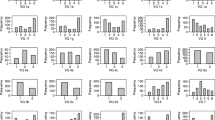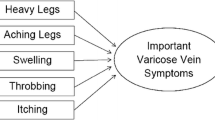Abstract
Approaches to measuring patient perceptions of outcome for varicose veins were tested using a postal questionnaire incorporating a clinically derived specific measure of varicose veins severity and the SF-36 health survey. The questionnaire was administered to 373 patients with varicose veins, 287 of whom had been referred to hospital for their varicose veins and 86 who had just consulted a general practitioner for the condition. The response rate exceeded 75%. Test-retest reliability was assessed by mailing patients a similar questionnaire at two weeks. The validity of the two instruments was assessed by comparing patient scores to general practitioner ratings of symptom severity and complications associated with varicose veins. Standardized response means (mean change in scores divided by the standard deviation of the change in scores) were used to quantify and compare the responsiveness of the two measures. Levels of test-retest reliability, as assessed by the intraclass correlation coefficient, were acceptable and the instruments appear to have good levels of validity. Patients who were or were not admitted to hospital for surgery on their veins had significant improvements in perceived health status on both the specific measure and the SF-36. The specific measure was the most responsive to changes in health status for both patients who were admitted to hospital for surgery and those receiving alternative forms of management. These two approaches might be suitable as part of a package of outcome measures for use in clinical trials to assess the effectiveness of different interventions for varicose veins.
Similar content being viewed by others
References
Coon WW, Willis PW, Keller JB. Venuous thromboemolism and other venous diseases in the Tecumseh Community Health Study. Circulation 1973; 48: 839–846.
Abramson JH, Hopp C, Epstein LM. The epidemiology of varicose veins. A survey in Western Jerusalem. J Epidemiol Community Health 1981; 35: 213–217.
Beaglehole R, Prior IAM, Salmond CE, Davidson F. Varicose veins in the South Pacific. Int J Epidemiol 1975; 4: 295–299.
Maffei FHA, Magaldi C, Pinho SZ, Lastoria S, Pinho W, Yoshida WB, Rollo H. Varicose veins and chronic venous insufficiency in Brazil: prevalence among 1755 inhabitants of a country town. Int J Epidemiol 1986; 15: 210–217.
Laurikka J, Sisto T, Auvinen O, Tarkka M, Laara E, Hakama M. Varicose veins in a Finnish population aged 40–60. J Epidemiol Community Health 1993; 47: 355–357.
Cambell WB. Varicose veins: an increasing burden on the NHS: BMJ 1990; 300: 763–764.
Eklof B. Modern treatment for varicose veins. Br J Surg 1988; 75: 297–298.
Scott HJ, McMullin GM, Coleridge Smith PD, Scurr JH. Venous disease: investigation and treatment, fact or fiction? Ann R Coll Surg Engl 1990; 72: 188–192.
Sarin S, Scurr JH, Coleridge Smith PD. Assessment of stripping the long saphenous vein in the treatment of primary varicose veins. Br J Surg 1992; 79: 889–893.
Thompson JF, Royle GT, Farrands PA, Najmaldin A, Clifford PC, Webster JHH. Varicose vein surgery using a pneumatic tourniquet: reduced blood loss and improved cosmesis. Ann R Coll Surg Eng 1990; 72: 119–122.
Jakobsen BH. The value of different forms of treatment for varicose veins. Br J Surg 1979; 66: 182–184.
Patrick DL, Deyo RA. Genericand disease-specific measures in assessing health status and quality of life. Med Care 1989; 27S: S217-S232.
Garratt AM, Ruta DA, Abdalla MI, Buckingham KJ, Russell IT. The SF-36 health survey questionnaire: an outcome measure suitable for routine use within the NHS? BMJ 1993; 306: 1440–1444.
Garratt AM, Macdonald LM, Ruta DA, Russell IT, Buckingham JK, Krukowski ZH. Towards the measurement of outcome for patients with varicose veins. Quality in Health Care 1993; 2: 5–10.
Kirshner B, Guyatt G. A methodological framework for assessing health indices. J Chron Dis 1985; 38: 27–36.
Ware JE, Snow KK, Kosinski M, Gandek B. SF-36 health survey manual and interpretation guide. Boston: Nimrod Press, 1993.
Ware JE, Sherbourne CD. The MOS 36-item short-form health survey (SF-36) I: Conceptual framework and item selection. Med Care 1992; 30: 473–483.
Tarlov AR, Ware JE, Greenfeld S, Nelson EC, Perrin E, Zubkoff M. The medical outcomes study: an application of methods for monitoring the results of medical care. JAMA 1989; 262: 925–930.
McHorney CA, Ware JE, Raczek AE. The MOS 36-item short-form health survey (SF-36): II. Psychometric and clinical tests of validity in measuring physical and mental health constructs. Med Care 1993; 31: 247–263.
McHorney CA, Ware JE, Rogers W, Raczek AE, Lu JF. The validity and relative precision of MOS short- and long-form health status scales and Dartmouth COOP charts. Results from the Medical Outcomes Study. Med Care 1992; 30 (Suppl): MS253-MS265.
Ruta DA, Garratt AM, Russell IT, Abdalla MI. The SF-36 health survey questionnaire: i reliability in two patientbased studies. Quality in Health Care 1994; 3: 180–185.
Deyo RA, Inui TS. Toward clinical applications of health status measures: sensitivity of scales to clinically important changes. Health Serv Res 1984; 19: 275–289.
Mackenzie CR, Charlson ME, DiGioia D, Kelley K. Can the Sickness Impact Profile measure change? An example of scale assessment. J Chron Dis 1986; 39: 429–438.
Deyo RA, Centor RM. Assessing the responsiveness of functional scales to clinical change: an analogy of diagnostic test performance. J Chron Dis 1986; 39: 807–906.
Bindman AB, Keane D, Lurie N. Measuring health changes among severely ill patients: the floor phenomenon. Med Care 1990; 28: 1142–1152.
Chester JF, Taylor RS. Hooker and French strippers: a technique for varicose veins surgery. Br J Surg 1990; 77: 560–561.
Kazis LE, Anderson JJ, Meenan RF. Effect sizes for interpreting changes in health status. Med Care 1989; 27 (Suppl): MS178-MS189.
Liang MH, Fossel AH, Larson MG. Comparisons of five health status instruments for orthopedic evalution. Med Care 1990; 28: 632–642.
Streiner DL, Norman GR. Health measurement scales: a practical guide to their development and use. Oxford: Oxford University Press, 1989.
Guyatt GH, Berman LB, Townsend M, Pugsley SO, Chambers LW. A measure of quality of life for clinical trials in chronic lung disease. Thorax 1987; 42: 773–778.
Ruta DA, Garratt AM, Chadha YC, Flett GM, Hall MH, Russell IT. Assessment of patients with menorrhagia: how valid is a structured clinical history as a measure of health status? Quality of Life Res 1995; 4: 33–40.
Burnard KG, Layer GT. Graduated elastic stockings. BMJ 1986; 293: 224–225.
Bishop CCR, Jarrett PEM. Outpatient varicose vein surgery under local anasthesia. Br J Surg 1986; 73: 821–822.
Author information
Authors and Affiliations
Additional information
This research and the Health Services Research Unit are both funded by the Chief Scientist Office of the Scottish Office Home and Health Department; however, the opinions expressed are those of the authors, not necessarily the SOHHD.
Rights and permissions
About this article
Cite this article
Garratt, A.M., Ruta, D.A., Abdalla, M.I. et al. Responsiveness of the SF-36 and a condition-specific measure of health for patients with varicose veins. Qual Life Res 5, 223–234 (1996). https://doi.org/10.1007/BF00434744
Received:
Accepted:
Issue Date:
DOI: https://doi.org/10.1007/BF00434744




